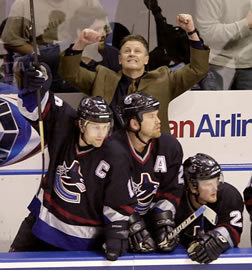Coaches warm to idea of open ice: 'What's best for ... hockey'
Page: S3, Section: Sports
Byline: James Mirtle, with files from Ed Willes, The Province
Source: National Post, with files from The Province
 TORONTO - While one meeting was held under the veil of secrecy yesterday, another took place at the NHL's Toronto offices, and it had little to do with collective bargaining and cost certainty. Six of the league longest-tenured coaches met with NHL officials with the goal of improving the quality of hockey played on the ice--whenever it should resume.
TORONTO - While one meeting was held under the veil of secrecy yesterday, another took place at the NHL's Toronto offices, and it had little to do with collective bargaining and cost certainty. Six of the league longest-tenured coaches met with NHL officials with the goal of improving the quality of hockey played on the ice--whenever it should resume.
To do so, the bench bosses in attendance took collective aim at a familiar foe: Obstruction.
"Everyone wants the same thing," said Vancouver head coach Mark Crawford. "I mean no one is against opening up the game and everyone wants to see that stars perform. The question is, how do you get there?"
The answer, said meeting chair and NHL director of hockey operations Colin Campbell, is to communicate the rules directly to players, officials and coaches. According to Campbell, the session was a step towards that goal.
"When you're talking to managers and coaches about the game while games are being played, they're just interested in how things best help their teams win," said Campbell.
"Now we're apart from the competitive, day-to-day battles, [and] we can discuss what's best for the game of hockey and what's going to open it up and make it more exciting. We also understand that when we come back ... we have to give something back to the fans. We talked about that a lot."
Yesterday's meeting is the latest in a series of attempts by the NHL to increase the game's flow. Previous initiatives to call more hooking, holding and interference penalties have met with limited success.
Reducing obstruction was also one of 10 recommendations made by a panel of hockey insiders at a recent summit organized by Detroit's Brendan Shanahan.
The NHL's clutch-and-grab mentality is often attributed to how defensive coaching has become. It was perhaps not a coincidence, then, that several of the coaches in attendance are notable for employing a defensive style of play.
Aside from Crawford, whose free-skating Canucks buck the trapping trend, the other coaches at the meeting were Florida's Jacques Martin, Philadelphia's Ken Hitchcock, Detroit's Dave Lewis, Colorado's Joel Quenneville and Buffalo's Lindy Ruff.
Despite the fact that an obstruction crackdown could hinder their individual teams, the coaches said they were united in making hockey a more entertaining product.
"One of the areas we talked about was rewarding the speed and skill of the players," said Lewis. "We wanted to enhance the vision of everyone on what obstruction is, when it's allowed and when it's not."
"Coaches look to improve their team and not necessarily the product," added Crawford. "With the break here, and with the pressure off, we can look at ways of speeding up the game and making it more open."
With the NHL having not played a game in months and labour negotiations dragging into late January, it may be a while before the ideas generated yesterday are implemented. And while he steadfastly refused to discuss CBA matters, Campbell said the lockout had been beneficial to the process.
"At the end, everyone wants to get back to the on-ice problems. If there is some silver lining with the lockout, it's that we have time now to do that."


